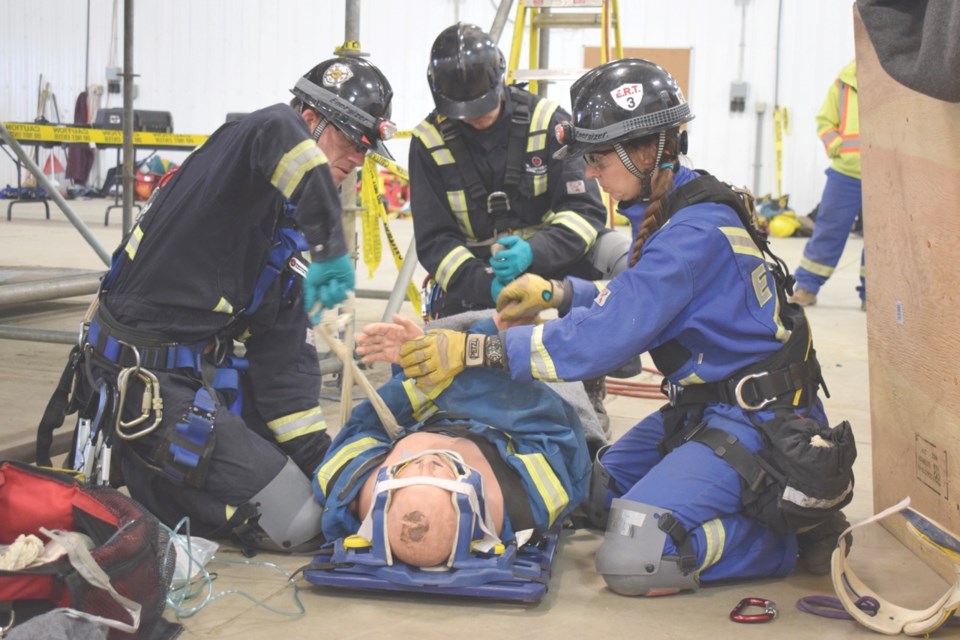They might not be training for a competition this year, but the Mine Rescue Team at Westmoreland Mining Holdings LLC’s Estevan Mine remains as dedicated as ever, learning and practising so they’re ready when called upon.
In a normal year, team members would be applying the finishing touches to their training for the annual Emergency Response/Mine Rescue Skills Competition that is held each year as the culmination of Saskatchewan Mining Week, and serves as a showcase of the talented and committed people who work at Westmoreland’s Estevan mine and for other mining companies across the province.
But this isn’t a normal year. The competition has been cancelled due to the COVID-19 pandemic. But that doesn’t mean the local team’s skills and efforts aren’t needed.
The team had to take a couple of months off due to COVID-19, but they’re back to practising, with their first session held on Friday. They’ll continue to meet once a month, and in the past they have also attended some training programs.
Guy Hiltz, who serves as the safety manager at the mine, said they draw members from throughout the mine, including operations, maintenance and the activated carbon plant, which is located near Bienfait.
“We want to try to get as many people involved from different areas, so they’re familiar with the surroundings we’re all going to be in,” Hiltz told the Mercury.
They always like to have new members join. Five people signed up late last year and early this year, and one person was at a practice for the first time Friday. Hiltz said they were hoping they could get new members trained for the competition, but the competition obviously didn’t happen this year.
In a couple of years, he hopes they’ll be ready.
“In a lot of cases, with new members, any time they come into this atmosphere, it’s like a deer in the headlights look, because I don’t think a lot of people realize what it is that we train on, when we talk about rope rescue or confined space entry,” said Hiltz.
“I think they’ve heard about it but I don’t think they understand what it’s all about until they see what we’re doing.”
The team that would have gone to the mine rescue competition would have seven or eight members. It consists of those who are available to take three weeks to train each day, or have been members in the past.
“We do try to mix in some cagey veterans with some new blood, just so that they get a taste of what it’s like,” said Hiltz.
During the past couple of months, team members have been meeting occasionally online to keep connected, but it’s obviously not the preferred way of training.
Team captain Brandon Schopp has been part of the team for the past seven years. He had no experience with the work that the mine rescue team performs before joining, but he found the work interesting and decided to give it a try.
“It’s a pretty close group of people, and they’re all pretty great to work with,” said Schopp.
Sometimes they’ll go a month or two without receiving a call, and other times they’ll get a couple of calls in a month.
A normal practice would see them work on ropes rescue, first aid, search and rescue, bookwork, theory, and firefighting over the course of eight hours.
Vice-captain Jessica Klarholm has also been a team member for the past seven years. She described it as a great opportunity to receive training that she would never receive anywhere else, and she learns things that she can apply to her day-to-day life, which includes riding horses and dirt bikes.
And she gets to meet some great people through the team.
Klarholm was excited to be back practising with her fellow team members.
“We’ve been waiting and waiting to hear when we can start, so we’re all very happy to be back,” she said.
In some cases, Klarholm hadn’t seen them in two or three months, because they all work different shifts.
The mine rescue team is important because it helps everyone feel safer in an industry that carries some on-the-job risks.
“Knowing that there are people here that can save your life within minutes, well, it’s helpful for me, anyways, on a ‘dozer at 3 a.m.,” she said.
To be a successful member, Klarholm said a person has to put in hours on their own time, and they have to be willing to know their team members.
The remaining members are team coach and co-ordinator Cory Gibson, team co-ordinator Steven Kitchen, Derek Choma, Josiah Anderson, Kevin Ducey, Lonnie Rooks, Tanner Weger-Brandow, Tyler Ursu, Brian Trombley, Jamie Rosengren, John Wells, Isaiah Adeniji, Matt Clausen, Travis Olver and Chris Jansen.



.png;w=120;h=80;mode=crop)
